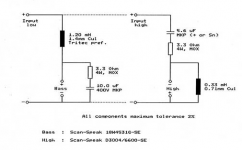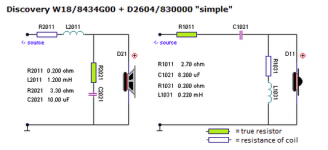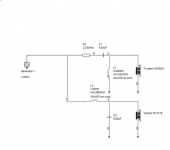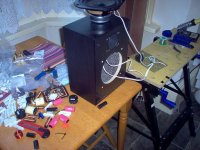I have a pair of unused 18w4531g00's and R3004/602000's lying around as I was going to use them in the car but went for horns instead. So I figured I'd turn them into a bookshelf speakers as my amp is 4ohm stable
I'm fairly new to this side of audio. I ran the tsp's through winisd and came out with 13.6L for sealed which is fine by me. Although madisound recommend 0.3-0.4 cu ft..
Would anyone recommend anything different?
I'm fairly new to this side of audio. I ran the tsp's through winisd and came out with 13.6L for sealed which is fine by me. Although madisound recommend 0.3-0.4 cu ft..
Would anyone recommend anything different?
What works in a car doesn't necessarily work at home. In this case doing a sealed cab means a too high F3, if the use is without a sub.
Without sub the smallest cab I'd do is some 25L tuned to 35Hz (vented), as this driver is really optimized for a vented cab. Play with unibox (free) to run some simulations.
However choosing a suitable box is only the smallest problem. Are you able to design a custom crossover that those drivers deserve? Have a look at this sticky for a design methodology (I prefer post #20): http://www.diyaudio.com/forums/multi-way/189847-introduction-designing-crossovers-without-measurement.html
Ralf
Without sub the smallest cab I'd do is some 25L tuned to 35Hz (vented), as this driver is really optimized for a vented cab. Play with unibox (free) to run some simulations.
However choosing a suitable box is only the smallest problem. Are you able to design a custom crossover that those drivers deserve? Have a look at this sticky for a design methodology (I prefer post #20): http://www.diyaudio.com/forums/multi-way/189847-introduction-designing-crossovers-without-measurement.html
Ralf
Hi,
A vented floorstander is the best option for no sub use.
A high quality x/o needs to be developed, very
similar to Zaph|Audio - ZRT - Revelator Tower.
Except of course, your dealing with 4 ohm drivers.
rgds, sreten.
A vented floorstander is the best option for no sub use.
A high quality x/o needs to be developed, very
similar to Zaph|Audio - ZRT - Revelator Tower.
Except of course, your dealing with 4 ohm drivers.
rgds, sreten.
Last edited:
Must say that I'm confused how many people have expensive units lying around without having a clue of what to do with them...
But I fully agree with Ralf and sreten. Dutch distributor Audiocomponents has developed the Reference Monitor. Slightly different tweeter, but the enclosure design works pretty good as I have experienced.
But I fully agree with Ralf and sreten. Dutch distributor Audiocomponents has developed the Reference Monitor. Slightly different tweeter, but the enclosure design works pretty good as I have experienced.
Thanks everyone. I can use a sub, but I'd have to get a minidsp plate amp or similar which I don't plan on doing for a little while. I have a whole lot of car audio SQ subs lying around so I might try those out in a few months when I get bored (boston g5, image dynamics idq12, idq10).
I sell car audio, so I have a lot of car audio lying around. These were intended for a car but I instead went with a horn/high sensitivity setup (a lot easier having a crossover at 800-1.25khz rather than 2.5khz up)
I was going to attack the crossover problem after I decide on an enclosure. I've had an offer of help with the crossover, Madisound have a crossover for this pair and zaph has one for the zrt I can reference to. I do have a umik I do measurements with also.
I'm getting results between 26L and 52L ported between winisd and unibox.. I guess I have a bit of learning to do with box simulations..
I sell car audio, so I have a lot of car audio lying around. These were intended for a car but I instead went with a horn/high sensitivity setup (a lot easier having a crossover at 800-1.25khz rather than 2.5khz up)
I was going to attack the crossover problem after I decide on an enclosure. I've had an offer of help with the crossover, Madisound have a crossover for this pair and zaph has one for the zrt I can reference to. I do have a umik I do measurements with also.
I'm getting results between 26L and 52L ported between winisd and unibox.. I guess I have a bit of learning to do with box simulations..
I think you have the wrong tweeter there. A 4 ohm Scanspeak R3004/6020 ring radiator car tweeter is not the sort of thing most domestic amplifiers are going to like driving. I'm not saying you couldn't get it working, but it'll be hard work and probably need third order.
https://www.madisoundspeakerstore.com/ring-radiator-tweeters/scanspeak-illuminator-r3004/6020-00-1-tweeter-small-ring-radiator/
You could return to the mainstream with a 104mm Vifa XT25 or Scan equivalent. Troels looks at a few variations on the W18 and ring radiator theme here. I suspect cabinet could be anything between 15L and 40L reflex really.
18W-8434G00
The 4 and 8 ohm versions of your bass driver look remarkably similar:
https://www.madisoundspeakerstore.com/scanspeak-woofers-6-7/scanspeak-revelator-18w/4531g-7-mid-woofer-4-ohm/
https://www.madisoundspeakerstore.com/scanspeak-woofers-6-7/scanspeak-revelator-18w/8531g-00-7-mid-woofer-8-ohm/
They even work on the same crossover. Much as I admire markbakk's very concrete suggestion for a Audiocomponents filter below, it falls into Troels' "Not to be Tried" category below.
Why? Well it doesn't do justice to the 6" Scanspeak bass. He invariably uses a midrange notch around 700Hz to get the sound right.
Studio-101
6" bass is a hard speaker IMO. It needs a complex crossover. Otherwise you are just building a middle of the road 4 ohm bass commercial design below.
www.audioexcite.com Wharfedale Diamond 10.2 review part 3
https://www.madisoundspeakerstore.com/ring-radiator-tweeters/scanspeak-illuminator-r3004/6020-00-1-tweeter-small-ring-radiator/
You could return to the mainstream with a 104mm Vifa XT25 or Scan equivalent. Troels looks at a few variations on the W18 and ring radiator theme here. I suspect cabinet could be anything between 15L and 40L reflex really.
18W-8434G00
The 4 and 8 ohm versions of your bass driver look remarkably similar:
https://www.madisoundspeakerstore.com/scanspeak-woofers-6-7/scanspeak-revelator-18w/4531g-7-mid-woofer-4-ohm/
https://www.madisoundspeakerstore.com/scanspeak-woofers-6-7/scanspeak-revelator-18w/8531g-00-7-mid-woofer-8-ohm/
They even work on the same crossover. Much as I admire markbakk's very concrete suggestion for a Audiocomponents filter below, it falls into Troels' "Not to be Tried" category below.
Why? Well it doesn't do justice to the 6" Scanspeak bass. He invariably uses a midrange notch around 700Hz to get the sound right.
Studio-101
6" bass is a hard speaker IMO. It needs a complex crossover. Otherwise you are just building a middle of the road 4 ohm bass commercial design below.
www.audioexcite.com Wharfedale Diamond 10.2 review part 3
Attachments
Hi,
I agree the tweeter is not ideal and will be hard work to get right.
I wouldn't consider it for a second if I did not actually have it.
Note that the madisound x/o, if for in car use, will be wrong.
The x/o topology I'd expect to be similar to the ZRT :
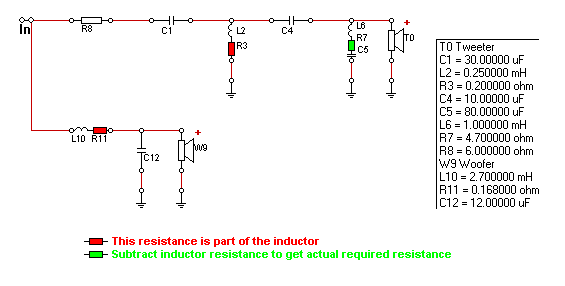
Box volume around 30L, search on Undefinitions
Commodore box design, it should be ideal.
(Its based on a Totem design aesthetic.)
rgds, sreten.
I agree the tweeter is not ideal and will be hard work to get right.
I wouldn't consider it for a second if I did not actually have it.
Note that the madisound x/o, if for in car use, will be wrong.
The x/o topology I'd expect to be similar to the ZRT :

Box volume around 30L, search on Undefinitions
Commodore box design, it should be ideal.
(Its based on a Totem design aesthetic.)
An externally hosted image should be here but it was not working when we last tested it.
rgds, sreten.
Last edited:
Midrange notches almost invariably work better than the usual oversized coil in correcting baffle step functions. As I found some 25 years ago... But optimal designs often neglect the simple fact that most speakers do not get the proper placement they deserve. As for the Audiocomponents scheme, it is as simple as they come, while very effective.Much as I admire markbakk's very concrete suggestion for a Audiocomponents filter below, it falls into Troels' "Not to be Tried" category below.
Why? Well it doesn't do justice to the 6" Scanspeak bass. He invariably uses a midrange notch around 700Hz to get the sound right.
Order a proper 6-7" waveguide and you`d solve several issues with your design - you`d achieve much better polar response, can use a single cap on the tweeter, less distortion below 2Khz and with something like the WG300 you`d get physical time alignment. I`d put the 4531 in 35l tuned to 35Hz.
It may be true, but then you need to have measurement capabilities.
I think you can mate the two drivers. Even if it is a ringradiator, the tweeter should work fine with a 2.0-2.5KHz LR4 (acoustic) HP - see Zaph's test for a XT25: Zaph|Audio. The woofer doesn't show signs of breakup so it can be crossed in that range quite easily.
Ralf
I think you can mate the two drivers. Even if it is a ringradiator, the tweeter should work fine with a 2.0-2.5KHz LR4 (acoustic) HP - see Zaph's test for a XT25: Zaph|Audio. The woofer doesn't show signs of breakup so it can be crossed in that range quite easily.
Ralf
You know, we often get people throw unlikely combinations of drivers at us here at diy.aspergers.com... 
TBH, a 4 ohm Scanspeak 4531 6" sliced paper bass and a 4 ohm car tweeter is about as weird as it gets. I'd actually get quite cross if someone SLASHED my bass cone with a Stanley knife and glued it back together with PVA wood glue. And then charged me $200 bucks for the privilege!
IMO, this combination of drivers is a complete no-hoper. I certainly wouldn't dedicate 3 months of my life to building it and, probably, abandoning it.
Even the 8 ohm version doesn't win any cigars: SP95
Maybe a Spendor BC1 homage looks a bit more interesting, even if very expensive with that 1.5" tweeter and supertweeter: SP38/13
But really, if spending big bucks, the prize really ought to be worth the effort: ScanSpeak-3W-Discovery
TBH, a 4 ohm Scanspeak 4531 6" sliced paper bass and a 4 ohm car tweeter is about as weird as it gets. I'd actually get quite cross if someone SLASHED my bass cone with a Stanley knife and glued it back together with PVA wood glue. And then charged me $200 bucks for the privilege!
IMO, this combination of drivers is a complete no-hoper. I certainly wouldn't dedicate 3 months of my life to building it and, probably, abandoning it.
Even the 8 ohm version doesn't win any cigars: SP95
Maybe a Spendor BC1 homage looks a bit more interesting, even if very expensive with that 1.5" tweeter and supertweeter: SP38/13
But really, if spending big bucks, the prize really ought to be worth the effort: ScanSpeak-3W-Discovery
for a bookshelf system, 24L tuned to ~38Hz would be OK; however the extended breakup region means you'd need to cross them over below 1.5KHz, 2nd order & add ~3Db BSC to match the tweeter sensitivity. Don't know how the tweeter would go being crossed over that low.... at least 3rd order required I'd say
You all trying to get me down on my knees laughing with your comments on the scan reference woofers? I like what I heard from designs with this unit. Getting the car tweeters matched could of course be painstaking, but then again, what's wrong with experimenting a bit with values on the HP-section using only one's ears and a fancy app on the smartphone?
but then you need to have measurement capabilities.
You cannot be a true multi-way speaker designer/builder without a mic and measurement software. Given the low price of a good calibrated USB mic ($20 to $70) and free REW or Holmimpulse software, there is no reason why anyone serious about their craft doesn't do measurements. It has improved my diy speaker sound quality and the overall process vastly. It is like being a watchmaker assembling a watch movement without a loupe or binocular magnifiers: sure, you could do (maybe), but you would be working mostly blind and taking a lot longer to do something, and not having as good a final product.
I gave this sort of design some consideration elsewhere:
http://www.diyaudio.com/forums/multi-way/147632-classic-monitor-designs-20.html#post4367109
It's going to be hard to do with those drivers, because it will best work with a 2.5-3kHz 3rd order crossover on a fairly gutless small tweeter, whereas the bass unit is probably going to be better around 1.5-2kHz crossover.
This 18W discovery design seems a point of departure:
18W-8434G00
Once you understand how it works, it's not hard to adapt it to other drivers in any of the 4 versions. You can guess the crossover values easily enough.
But, TBH, I think 6" paper bass is rather unrewarding. I'd fancy a polycone like a Vifa P17WJ a lot more. I did about 6 filters for my 6" effort, and none of them really won a cigar.
http://www.diyaudio.com/forums/multi-way/147632-classic-monitor-designs-20.html#post4367109
It's going to be hard to do with those drivers, because it will best work with a 2.5-3kHz 3rd order crossover on a fairly gutless small tweeter, whereas the bass unit is probably going to be better around 1.5-2kHz crossover.
This 18W discovery design seems a point of departure:
18W-8434G00
Once you understand how it works, it's not hard to adapt it to other drivers in any of the 4 versions. You can guess the crossover values easily enough.
But, TBH, I think 6" paper bass is rather unrewarding. I'd fancy a polycone like a Vifa P17WJ a lot more. I did about 6 filters for my 6" effort, and none of them really won a cigar.
Attachments
System 7 - have you used the 18W in your own projects and can you post an example here? I get the sense you haven`t. It is a large step above the PL-series in every aspect - dynamics, low frequency performance, transparency, linearity. The distortion of this driver doesn`t rise much with increased power levels, something I did not observe with the PL-series. Indeed, comparison with these is not relevant at all. The only drivers that could bring up the question is the extra price for the Revelator worth are the NRXC SB Acoustics drivers. Perhaps the only drawback I noticed with the Revelator, was its performance in the low midrange - it has a specific sound which, at least to my taste, colors the sound and when you listen to a speaker using this driver, you`d easily recognize it. This is why I didn`t use neutrality in my first words. The only non-exotic driver I would buy over that one ( still after so many years in production ) is the newer SB Satori MW19P and that`s only based on paper but according to the initial published data, to me it looks like a superior unit and I like the SB hard paper cones better.
The rise in the frequency response is not as steep as shown on the SS own data, easy to deal with, just use a larger inductor according to taste. For a 2.5Khz crossover point ( max recommended ) a 1.35mH would do the trick. if you use it that high, you`d get into directivity issues which are easily observable, the cone area is closer to a 7" driver, either incorporate a waveguide to load the tweeter adequately, or use a lower crossover point.
The rise in the frequency response is not as steep as shown on the SS own data, easy to deal with, just use a larger inductor according to taste. For a 2.5Khz crossover point ( max recommended ) a 1.35mH would do the trick. if you use it that high, you`d get into directivity issues which are easily observable, the cone area is closer to a 7" driver, either incorporate a waveguide to load the tweeter adequately, or use a lower crossover point.
Last edited:
- Status
- This old topic is closed. If you want to reopen this topic, contact a moderator using the "Report Post" button.
- Home
- Loudspeakers
- Multi-Way
- Scanspeak 4531g bookshelf design help
